
A phalarope is any of three living species of slender-necked shorebirds in the genus Phalaropus of the bird family Scolopacidae.

Scolopacidae is a large family of shorebirds, or waders, which mainly includes many species known as sandpipers, but also others such as woodcocks, curlews and snipes. The majority of these species eat small invertebrates picked out of the mud or soil. Different lengths of bills enable different species to feed in the same habitat, particularly on the coast, without direct competition for food.
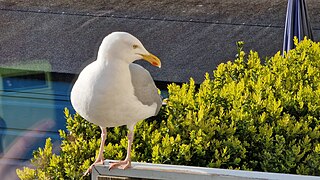
Gulls, or colloquially seagulls, are seabirds of the family Laridae in the suborder Lari. They are most closely related to the terns and skimmers and distantly related to auks, and even more distantly to waders. Until the 21st century, most gulls were placed in the genus Larus, but that arrangement is now considered polyphyletic, leading to the resurrection of several genera. An older name for gulls is mews, which is cognate with German Möwe, Danish måge, Swedish mås, Dutch meeuw, Norwegian måke/måse, and French mouette, and can still be found in certain regional dialects.

Terns are seabirds in the family Laridae, subfamily Sterninae, that have a worldwide distribution and are normally found near the sea, rivers, or wetlands. Terns are treated in eleven genera in a subgroup of the family Laridae, which also includes several genera of gulls and the skimmers (Rynchops). They are slender, lightly built birds with long, forked tails, narrow wings, long bills, and relatively short legs. Most species are pale grey above and white below with a contrasting black cap to the head, but the marsh terns, the black-bellied tern, the Inca tern, and some noddies have dark body plumage for at least part of the year. The sexes are identical in appearance, but young birds are readily distinguishable from adults. Terns have a non-breeding plumage, which usually involves a white forehead and much-reduced black cap.

The crab-plover or crab plover is a bird related to the waders, but sufficiently distinctive to merit its own family Dromadidae. Its relationship within the Charadriiformes is unclear, some have considered it to be closely related to the thick-knees, or the pratincoles, while others have considered it closer to the auks and gulls. It is the only member of the genus Dromas and is unique among waders in making use of ground warmth to aid incubation of the eggs.

The ibisbill is a bird related to the waders, but sufficiently distinctive to merit its own family Ibidorhynchidae. It is grey with a white belly, red legs and long down-curved bill, and a black face and black breast band. It occurs on the shingle riverbanks of the high plateau of central Asia and the Himalayas.

The sheathbills are a family of birds, Chionidae. Classified in the wader order Charadriiformes, the family consists of one genus, Chionis with two species. They breed on subantarctic islands and the Antarctic Peninsula, and the snowy sheathbill migrates to the Falkland Islands and coastal southern South America in the southern winter; they are the only bird family endemic as breeders to the Antarctic region. They are also the only Antarctic birds without webbed feet.
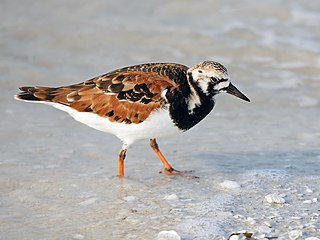
The ruddy turnstone is a small cosmopolitan wading bird, one of two species of turnstone in the genus Arenaria.

The black turnstone is a species of small wading bird. It is one of two species of turnstone in the genus Arenaria the ruddy turnstone being the other. It is now classified in the sandpiper family, Scolopacidae, but was formerly sometimes placed in the plover family, Charadriidae. It is native to the west coast of North America and breeds only in Alaska.

The common ringed plover or ringed plover is a small plover that breeds across much of northern Eurasia, as well as Greenland. The genus name Charadrius is a Late Latin word for a yellowish bird mentioned in the fourth-century Vulgate. It derives from Ancient Greek kharadrios a bird found in ravines and river valleys. The specific hiaticula is Latin and has a similar meaning to the Greek term, coming from hiatus, "cleft" and -cola, "dweller".
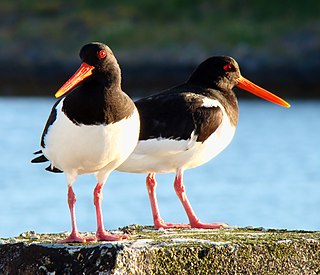
The Eurasian oystercatcher also known as the common pied oystercatcher, or just oystercatcher, is a wader in the oystercatcher bird family Haematopodidae. It has striking black and white plumage, a long straight orange-red bill, red eyes and relatively short dull pink legs. The sexes are similar in appearance but the bill of the female is longer than that of the male.

The ruff is a medium-sized wading bird that breeds in marshes and wet meadows across northern Eurasia. This highly gregarious sandpiper is migratory and sometimes forms huge flocks in its winter grounds, which include southern and western Europe, Africa, southern Asia and Australia.

The Eurasian dotterel, also known in Europe as just dotterel, is a small wader in the plover family of birds. It is the only species placed in the genus Eudromias.

The Siberian sand plover is a small wader in the plover family of birds. The International Ornithologists' Union split the Tibetan sand plover from the lesser sand plover and changed its vernacular name to Siberian sand plover. The specific mongolus is Latin and refers to Mongolia, which at the time of naming referred to a larger area than the present country.
The Mud Islands reserve is located within Port Phillip, about 90 km (56 mi) south-west of Melbourne, Australia, lying 10 km (6.2 mi) inside Port Phillip Heads, 7 km (4.3 mi) north of Portsea and 9 km (5.6 mi) east of Queenscliff. The land area of about 50 hectares is made up of three low-lying islands surrounding a shallow tidal 35-hectare (86-acre) lagoon connected to the sea by three narrow channels. The shapes and configuration of the islands change over the years due to movement of sand by tidal currents.

The Egyptian plover, also known as the crocodile bird, is a wader, the only member of the genus Pluvianus. It occurs in a band across Sub-Saharan Africa from Senegal in the west to Ethiopia in the east and south to parts of the Democratic Republic of the Congo. It no longer occurs in Egypt. The species was formerly placed with the pratincoles and coursers in the family, Glareolidae, but is now regarded as the sole member of its own monotypic family Pluvianidae.

Kittlitz's plover is a small shorebird in the family Charadriidae that breeds near coastal and inland saltmarshes, sandy or muddy riverbanks or alkaline grasslands with short vegetation. It is native to much of Sub-Saharan Africa, the Nile Delta and Madagascar. It is thought to be mainly polygamous and has monomorphic plumage.
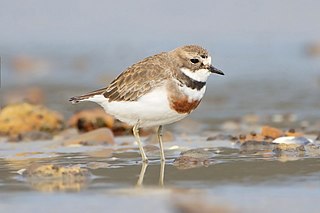
The double-banded plover, known as the banded dotterel or pohowera in New Zealand, is a species of bird in the plover family. Two subspecies are recognised: the nominate Charadrius bicinctus bicinctus, which breeds throughout New Zealand, including the Chatham Islands, and Charadrius bicinctus exilis, which breeds in New Zealand's subantarctic Auckland Islands.
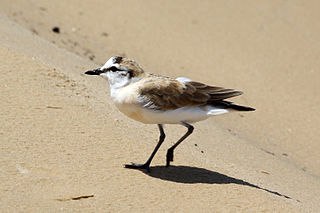
The white-fronted plover or white-fronted sandplover is a small shorebird of the family Charadriidae that inhabits sandy beaches, dunes, mudflats and the shores of rivers and lakes in sub-saharan Africa and Madagascar. It nests in small shallow scrapes in the ground and lays clutches of one to three eggs. The species is monogamous and long-lived, with a life expectancy of approximately 12 years. The vast majority of pairs that mate together stay together during the following years of breeding and retain the same territory. The white-fronted plover has a similar appearance to the Kentish plover, with a white fore crown and dark bands connecting the eyes to the bill.

The Kentish plover is a small wader of the family Charadriidae that breeds on the shores of saline lakes, lagoons, and coasts, populating sand dunes, marshes, semi-arid desert, and tundra. Both male and female birds have pale plumages with a white underside, grey/brown back, dark legs and a dark bill; however, additionally the male birds also exhibit very dark incomplete breast bands, and dark markings either side of their head, therefore the Kentish plover is regarded as sexually dimorphic.
























